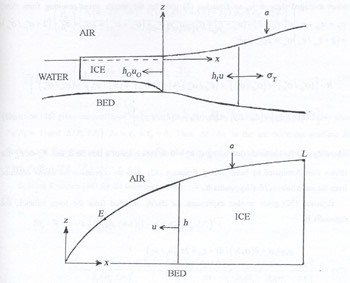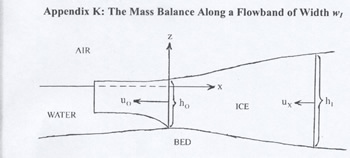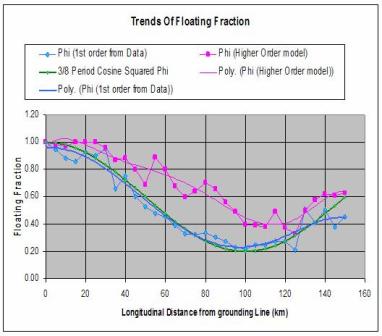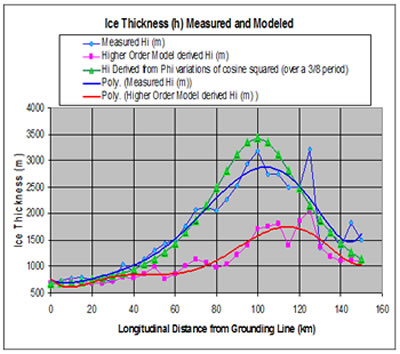
Introduction
Research
The model is used to provide a first order understanding of the thickness of an ice sheet as it spreads across a continental land mass, progressing from Sheet Flow to Stream Flow to Shelf Flow
Sheet Flow: a grounded ice sheet with 100% of its basal surface frozen to its bed
Stream Flow: a mass of ice, flowing toward the sea whose basal surface is partially afloat and partially frozen to its bed.
Shelf Flow: a large floating area of Ice.
Ice Sheet thickness progresses from its thickest state as a grounded ice sheet to its thinnest where it is 100% afloat at its grounding line boundary.
Once afloat the ice shelf continues to thin due to the force of gravity and difference in density between ice and water.
Byrd
Glacier Data and Model Results
The
top graph shows the results of the RADAR data providing ice sheet thickness.
The lower graph shows the results of a model interpretation of the data
with regard to the stream’s floating fraction (Pw/PI): a 2nd-3rd
order approximation of the floating fraction Phi.

Hypothesis
The natural tendency of grounded ice is to seek sea level
A first order approach should provide a reasonable description of the ice sheet & stream thickness as it flows toward its ice shelf grounding line.
Continental ice proceeds from totally grounded sheet flow to partially floating stream flow to totally floating ice flow behavior based on the relative coupling of the ice to its bed
Increases in sea level reduce the coupling and lead to faster stream flow and thinner streams.
The first order model captures the variability of bed coupling through the parameter “Phi” defined as the floating fraction of the ice stream
Phi = 0 for totally grounded ice
Phi = 1 for totally floating ice
The derived first order value for Phi= ho/hI
First
Order Model
The ice sheet frozen to its bed assumes a parabolic shape.
Ice Sheets on land terminate as ice lobes
Partially submerged ice sheets become ice streams as bed coupling diminishes
Ice streams terminate as floating ice shelves

The
Floating Fraction Phi
Higher order models of the thickness, include side shear stress, mass balance and compression and tension forces.

Variation
of Phi By Model
Pink shows Higher Order Model Phi (Phi=Pw/PI) from RADAR data.
Green is the First Order Phi = ho/hI varying as cosine squared through 3/8 of a period

Ice
Thickness By Model
Pink shows ice thickness derived from the Higher Order Model Phi (Phi=Pw/PI)
Green is the thickness of ice derived from First Order Phi varying as cos2(3•p•x/(2•L)) for 3/8 of a period
